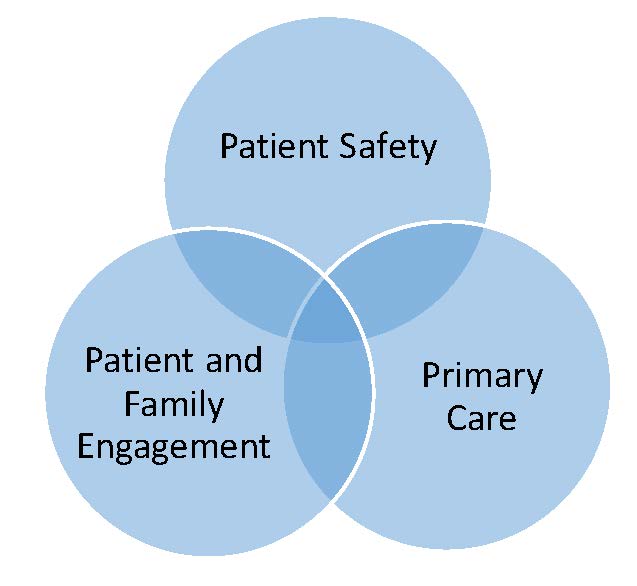Environmental Scan Report
Background
Patient and family engagement (PFE) is an evolving concept in health care transformation in the United States and worldwide. Within the past 5 years, a number of frameworks have been developed that call for PFE as a way to achieve patient-centered care. This goal is based in medical ethics and human rights1–4 and one of six aims set forth by the Institute of Medicine as fundamental to health care reform in the 21st century.5
A growing body of evidence suggests that PFE can improve the safety and quality of care delivery.4,6–9 Although the field of PFE in patient safety for hospitals and health systems is maturing, the use of PFE to improve patient safety in nonacute settings is in its infancy,10,11 but with a growing literature base.
Building sustainable processes and practice-based infrastructure is crucial to improving patient safety by PFE in primary care. The Guide to Improving Safety in Primary Care Settings by Engaging Patients and Families (hereafter referred to as the Guide), sponsored by the Agency for Healthcare Research and Quality (AHRQ), is being developed to provide primary care practices with interventions they can use to engage patients and families in ways that lead to improved patient safety. This comprehensive guide will include explicit instructions to help primary care practices, providers, and patients and families adopt new behaviors to increase patient and family engagement to improve patient safety.
We are using the Translating Evidence into Practice (TRiP) model12,13 as the conceptual framework for comprehensive guide development, implementation, and evaluation. We selected the TRiP model because it emphasizes intervention adoption and sustainability. The model is conceptually simple, is easy to relate to diverse audiences, and can be used to guide diffusion by establishing flexible work processes that can be customized to meet local practice demands and culture.14
The TRiP framework13 is composed of four discrete stages bundled together to:
- Review the latest evidence;
- Identify potentially effective and feasible interventions, test and refine practices with multidisciplinary team input, and implement interventions;
- Measure performance; and
- Spread and embed interventions into routine practice to meet the needs of all patients.
We performed an environmental scan to accomplish Stage 1 of the TRiP framework (Summarize the Evidence); this report documents the environmental scan.
Purpose
An environmental scan is an integral process for identifying, retrieving, and organizing information to enable health decisionmaking and has been used to foster knowledge translation in primary care.15,16 The purpose of the environmental scan was to identify:
- Descriptive, qualitative, and quantitative studies on methods to engage patients and families in their care in primary care settings and the impact of these methods on patient safety; roles that health care providers play in engagement; facilitators and barriers to engagement; and other contextual factors that affect engagement.
- Existing interventions and associated tools and materials for engaging patients and families in the primary care setting to improve safety.
- Gaps between existing tools and materials and those that need to be developed to ensure that the Guide is comprehensive in addressing the various ways patients and families can be engaged in a primary care setting.
- Examples of at least eight primary care practices that have succeeded in engaging patients and families in their care, which has led to improvements in patient safety.
The environmental scan included conducting a targeted review of the peer-reviewed literature, conducting a targeted review of the grey literature, and receiving input from domain experts in patient safety, primary care, and patient and family engagement.
Conceptual Framework for Environmental Scan
While the goal of the environmental scan was to identify interventions that intersect all three domains (patient safety, primary care, and PFE), there was concern that interventions meeting this criterion would be rare. Therefore, the environmental scan aimed to identify and review interventions that covered at least two of the three domains and could meet the third with additional development.
PFE interventions that improved patient safety in acute care settings and could be applied to primary care were included. We also considered PFE interventions in primary care that were not evaluated for patient safety impact, but based on expert opinion could be modified or used to improve patient safety in primary care. Interventions in primary care that improved patient safety but did not explicitly include PFE were included if they could be expanded to incorporate PFE strategies with additional development.
Based on the purpose of the environmental scan, a simple conceptual framework emerged to describe the relationship between these three domains (Figure 1).
Figure 1. Conceptualization of Evidence for Environmental Scan

For the purposes of this environmental scan, the following definitions were used:
- Patient Safety: "the freedom from accidental or preventable injuries produced by medical care." Practices to improve patient safety thus include those that reduce the occurrence of preventable adverse events.17
- Patient Engagement: "a set of behaviors by patients, family members, and health professionals and a set of organizational policies and procedures that foster both the inclusion of patients and family members as active members of the health care team and collaborative partnerships with providers and provider organizations."1,18
- Primary Care: "the provision of integrated, accessible health care services by clinicians who are accountable for addressing a large majority of personal health care needs, developing a sustained partnership with patients, and practicing in the context of family and community."19,20



